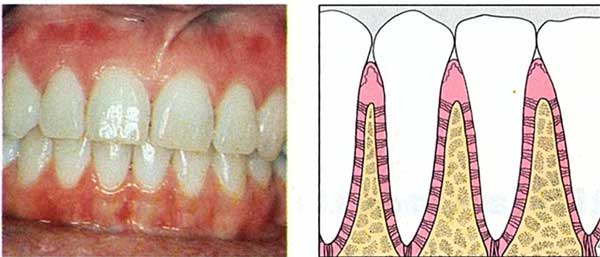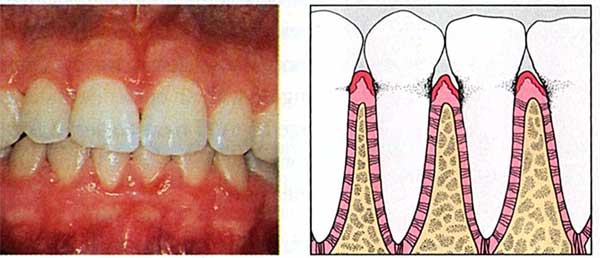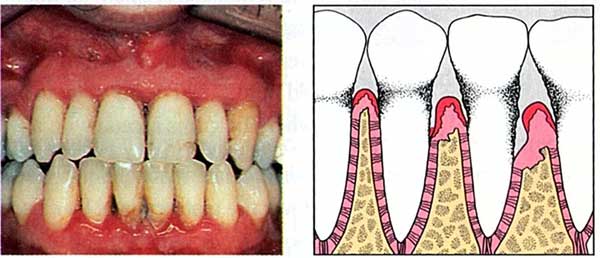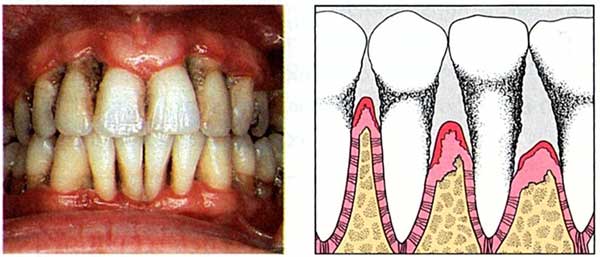Treating Periodontal Disease
Information contained in this article is provided by the American Dental Association.
 While watching television you probably have noticed that periodontal disease has made it to prime time advertising. At the drugstore, you now encounter a dazzling array of products for home dental care. Treating periodontal disease is critical to your overall health.
While watching television you probably have noticed that periodontal disease has made it to prime time advertising. At the drugstore, you now encounter a dazzling array of products for home dental care. Treating periodontal disease is critical to your overall health.
And for millions of people the emphasis in dental visits has shifted from treatment of tooth decay to prevention of periodontal disease, known to most of us as gum disease. Plaque, the sticky, colorless layer of bacteria that constantly forms in the mouth, is becoming more familiar to us all as the major cause of periodontal disease as well as tooth decay.
Advances in modern dentistry and new preventive tools are helping you keep your mouth healthy. Increasingly, adults can look forward to keeping their natural teeth throughout their life. But your "dental destiny" is literally in your own hands. Your own daily effort, combined with regular professional care, will ensure that you keep a healthy smile that lasts a lifetime.
What is Periodontal Disease?
There actually are several types of periodontal disease. All are started by a bacterial infection that destroys the gums, bone and ligaments supporting the teeth. Periodontal disease progresses slently, often without pain or overt symptoms that would alert you to its presence. It may develop slowly or progress quite rapidly.
Despite unparalleled advances in dentistry and breakthroughs in research, periodontal disease remains a serious dental health problem. Nine out of 10 people are afflicted by it in the course of their lives. Responsible for considerable tooth loss in adults, periodontal disease currently affects more than half of the population over age 18.
After age 35, about three out of four adults develop some form of gum disease. If you notice any of the following early warning signs, see your dentist immediately:
- Gums bleeding when you brush your teeth. Even a little bleeding is not normal. If you have a "pink" toothbrush, see your dentist.
- Red, swollen, or tender gums.
- Detachment of the gums from the teeth.
- Puss that appears from the gumline when the gums are pressed.
- Teeth that have become loose or changed position.
- Any change in the way your teeth fit together when you bite.
- Any change in the fit of partial dentures.
- Chronic bad breath or bad taste.
How do periodontal problems develop?
Bacteria begins to form and multiply in the mouth shortly after birth. Almost immediately, our lifelong battle against plague begins. Plaque is composed mostly of bacteria, in combination with saliva, food and fluid secreted by the gums.
The heaviest concentrations of plaque tend to be at the point where the teeth meet the gums and between the teeth. If not removed daily, the bacteria in plaque multiply into colonies. In time, unremoved plaque hardens into tartar, a tough, gritty deposit that gives new plaque a rough surface to which it can cling.
Tartar can be removed only by a dentist or dental hygienist. The amount of plaque and tartar that form can vary greatly from person to person. Specific types of bacteria in plaque produce substances toxic to the gums and bone that hold the teeth in place. If plaque is allowed to grow, an inflammation of the gums called gingivitis occurs.
As periodontal disease progresses, gums begin to pull away and recede from the teeth. Pockets of bacteria form and deepen, gradually reaching and destroying the bone that anchors the teeth. In this advanced stage, known as periodontitis, teeth may be lost without prompt treatment by a dentist. While plaque is the chief cause of periodontal disease, other factors can influence your chances of developing the disease.
Conditions that interfere with the immune system--such as hormone imbalances from diabetes, thyroid malfunction and pregnancy - some medications, and hereditary factors all may increase the risk or severity of the disease. Tests are now being developed to identify factors that make some people more likely to develop periodontal disease.
Periodontal Illustrations
- 1. Normal, Healthy Gingiva (Gums) Healthy gums and bone anchor teeth firmly in place.

- 2. Gingivitis Plaque and its byproducts irritate the gums, making them tender, inflamed, and likely to bleed.

- 3. Periodontitis Unremoved, plaque hardens into calculus (tartar). As plaque and calculus continue to build up, the gums begin to recede (pull away) from the teeth, and pockets form between the teeth and gums.

- 4. Advanced Periodontitis The gums recede farther, destroying more bone and the periodontal ligament. Teeth, even healthy teeth-may become loose and need to be extracted.

Last Updated: September 19, 2022
About UDE
UDE is a free service designed to help place perspective patients with various oral care providers in close proximity. USA Dental Edge organizes oral care providers primarily by county (or borough/parish).




